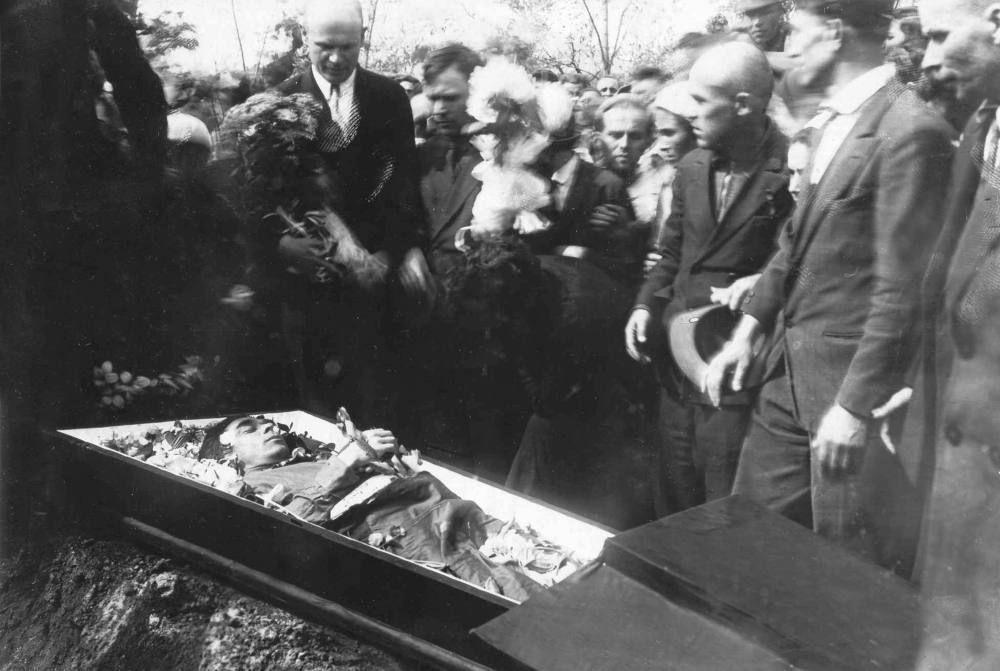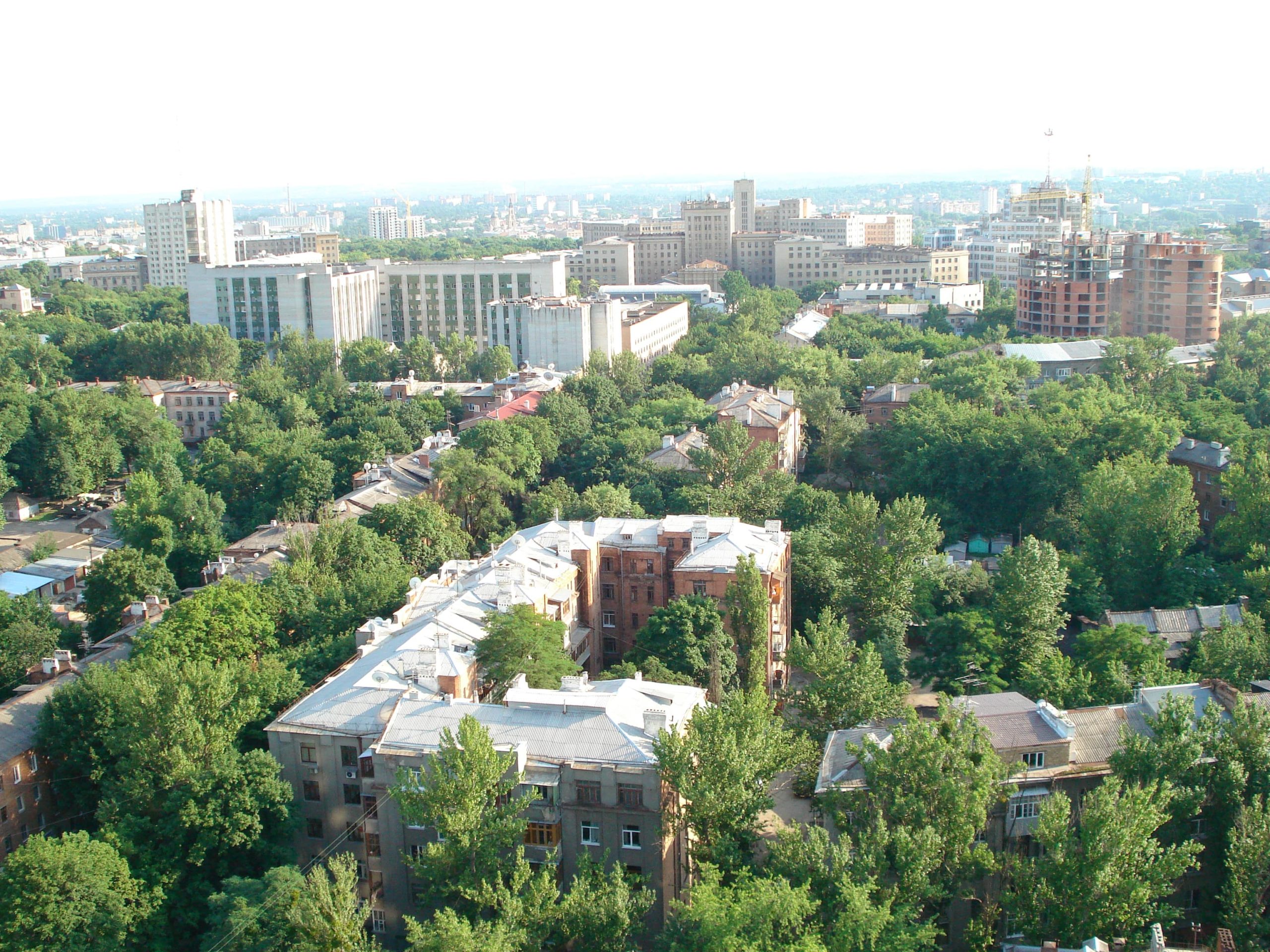At the end of the 1920s, a unique house in the shape of a letter C was built in Kharkiv. Its shape reflected the letter C in the Ukrainian word слово ("slovo"), meaning “word” (derived from the Greek letter sigma - ς - the Cyrillic letter for S is С and its name was slovo 'word' up until it was simplified to only "Es" when most of the letter designations were reduced to one-syllable names in the 20th century, - Ed.). Thus, the form of the building symbolized that it was constructed specially for prominent Ukrainian writers, all of whom had to live there in a total of 66 apartments.
The “bright” Soviet idea of a special house for like-minded intellectuals with new luxury apartments had its dark side. They came under the total control of the state. In 1929, when the first future residents were choosing their apartments, few predicted that phones specially installed in each apartment (yet uncommon for that time) would become key witnesses to persecute most of the writers and make others frightened and submissive.
After the occupation of the Ukrainian state by the Bolsheviks in 1919 and the creation of the Ukrainian Soviet Socialist Republic, the Soviet regime was still too weak to impose total control and eliminate national or ethnic cultural borders in favor of a united proletarian class. Therefore, Lenin’s policy of korenizatsiya (nativization) was designed. In Ukraine, it was ukrainization that had to introduce local elites to the local Soviet government, as well as allow local cultural development. Indeed, Ukrainian literature at that time experienced a renaissance that later, unfortunately, turned into an Executed Renaissance. The story of Slovo House is a small chapter in the story of the whole Ukrainian cultural elite.
Slovo as an implemented Soviet dream of communal and one-professional housing
The eastern Ukrainian city of Kharkiv, where Slovo House was located, served as the capital of Soviet Ukraine in 1919-1934. It meant that Ukrainian culture and prominent Ukrainian artists moved to this city from all over Ukraine. These included Ukrainian movie and theater director Les Kurbas, as well as Ukrainian writers Mykola Khvyliovyi, Mykola Kulish, Ostap Vyshnia, poet Volodymyr Sosiura, and many others.
At first, Ukrainian writers lived in poor conditions, experiencing harsh economic situations after WWI. Those few who belonged to the former aristocracy and were not exiled had to accommodate some proletarians in the “free” rooms of houses that were no longer theirs. Others, like Pavlo Tychyna for example, could not pay for any accommodation from his small salary and lived in an office.

Those who came from villages, little towns, and even Kyiv couldn't afford to rent a place to live since prices in Kharkiv were higher than even Kyiv ones. Salaries weren't enough and they weren't always paid on time. Men of letters lived and worked in bedsits, 3-meter shells, kitchens, slept right on the floor, newspapers substituting blankets, kept their manuscripts in cooking pots to save it from being eaten by mice and rats, - a summary of ProSlovo research project says.
In the Soviet Union, where class and professional identity were more important than cultural, ethnic, religious or any other identity, the housing issue was also solved in accordance with professions. It was common to build separate houses for railroaders, school teachers, party nomenklatura, etc. In the framework of this ideology, a project of a special house for Ukrainian writers was interpreted as merely one example of this general trend. Neighbors of Slovo were two houses for railroad officials and for aviation chiefs.
Nonetheless, the construction of the Slovo was more complicated. In the middle of the 1920s, Ukrainian writers petitioned the Soviet government to construct a cooperative building. The government supported the project and provided finance. However, dwellers had to pay the money back within 15 years, something which was not a common Soviet approach.
Slovo was projected by the architect Mykola Dashkevych. The house was built with the best materials available at that time. The construction of Slovo started in 1927 and lasted for two years. However, in 1929 some more money was required to finish the project. That year, Ukrainian writers were visiting Moscow during “Ukrainian week” and Ostap Vyshnia dared to ask Stalin himself for money to finish the project. He received the money the same day without delay.
Did Stalin indeed care that much about Ukrainian writers? Very soon they would come to realize that a building like Slovo was perfect for the regime to watch and persecute. Few agents of secret police among intellectuals could easily determine the real thoughts of all in the house. Moreover, phones were installed at each apartment which was not common at that time. Phone conversations made the task of looking for enemies easier.
Meanwhile, at the end of 1929, the Newspaper “Ukrvisti” reported that the building was finished:
"Now we are free to say that Ukrainian writers, at least most of them, have accommodation where they can work in proper conditions. That is the house of writers Slovo, construction of which started a couple of years ago and finished just recently. It is located not far from the Derzhprom building [the Palace of Industry, the highest building in Europe in 1928]. More than 60 writers with their families will be placed there. The settlement of the house has already begun."
Although close to the city center, Slovo was also located in the cozy suburbs of the city. As Volodymyr Kulish, the son of killed Ukrainian writer Mykola Kulish writes in his memoirs, all apartments had 3 or 4 rooms, which was very high for the standard of living in the 1920s. Moreover, on the ground floor, a kindergarten was organized, while on the roof the architect designed a solarium.

Now there is enough space for a big library and even for a grand piano. Vyshnya, a big fan of hunting, gives his dogs whole rooms. Even though some difficulties still occurred such as mice, moths, coal heating,etc., such living conditions were luxury for that time, - ProSlovo research project summarizes.
Repression
The first arrest happened in 1931. An actress Galina Orlivna was arrested on 20 January that year and sentenced to five years’ imprisonment. She would never be allowed to return to Ukraine.
Then arrests came one by one for "counterrevolutionary agitation using literature works" or similar charges. In 1932, a famous Ukrainian author Ivan Bahrianyi was arrested.
In 1933, the largest number of arrests were conducted. In particular, Ukrainian writer Mykhailo Yalovyi was arrested for “espionage.” The next day after Yalovyi's arrest, Ukrainian writers Mykola Khvylovy, Mykola Kulish and Oles Dosvitniy were talking about Yaloviy's case and trying to find ways to solve the problem. However, just at the time of the conversation, Khvylovy went to his room and shot himself. This story shows precisely the scope of despair that writers experienced.

Was it only because of the arrest of fellows? No. 1932 and 1933 were the years when the Stalin-made famine, Holodomor, killed four million Ukrainians, mostly peasants. Writers, of course, knew the situation and probably saw many deaths themselves. The dramatic change of policy, from the provision of the new cozy house to genocide, was incomprehensible.
Overall, the wave of repressions hit 40 out of 66 apartments in Slovo house. The number of executed was 33, with five sentenced to long terms of imprisonment, one committing suicide, and another killed under unclear circumstances. This wave of repression against the cultural elite, conducted at the time of the Holodomor, is yet one more proof that the Holodomor was an intentional policy of genocide towards Ukrainians, not merely a great famine caused by Soviet economic policy.
In 1934 after Holodomor and repression, the capital of Ukraine was moved from Kharkiv to Kyiv. Subsequently, a RoLit house was built in Kyiv. By the model of Slovo, it accommodated most of the remaining writers in one house in the new capital.
Sandarmokh
Most of those who were finally executed initially received terms of imprisonment. However, in 1937 something changed Stalin’s plans. In Sandarmokh, situated in Russian Karelia, between 27 October and 4 November 1937 the regime executed 1,111 prisoners to honor the 20th anniversary of the October Revolution. More than 200 of them were Ukrainians, mostly political prisoners or intellectuals. Among Slovo dwellers, at least 11 were killed in Sandarmokh: Les Kurbas, Mykola Kulish, Hryhoriy Epik, Andriy Paniv, Mykhailo Yalovyi, Antin Krushelnytskyi, his sons Bohdan and Ostap, daughter Volodymyra, Valerian Polishuk, Valerian Pidmohylnyi.

Public activists found the site of mass executions in Sandarmokh in July 1997. A total of 236 pits with corpses have been found in the area. During the 1930s, Stalin’s regime killed at least 9,500 prisoners in Sandarmokh.
Project ProSlovo
In March 2017, the ProSlovo project was launched in Ukraine. The research project is dedicated specifically to the Slovo House and its residents, with all results being published on the web-page in interactive form.
In English, one can follow the timeline of Slovo House, from the time when the idea of this house emerged until today. Also available with Ukrainian comments are:
- 3D visualization with the possibility to click on each apartment
- Photos of all residents
- A literary map of Kharkiv
- Thematic photos
The 2017 documentary Slovo House
In 2017, a documentary was released, where one can see what was the life of writers in the communal Slovo House and how they were executed one by one. Starting with optimism, the film darkens right through to the end, when the house is left without its inhabitants. The contrast is brought to the limit as the story of each writer is told with specific details from their life, taken from their own or their neighbors’ memoirs.
The script to the film was written by Liubov Yakymchuk and Taras Tomenko, and directed by the latter. Originally, the script was 450 pages long, although later cut to a more typical length of 45 for one film.
The premiere of the documentary provoked a discussion in Ukraine. From the Ukrainian point of view, many inhabitants of the Slovo House were to some extent collaborators of the Bolsheviks who occupied the territory of the Ukrainian People’s Republic in 1919. Kulish and Khvyliovyi even participated in battles with the army of the Ukrainian state. Ideologically they were communists who however were able to realize their creative potential in the context of a short-lived policy of Ukrainization. Nonetheless, regardless of the political role of certain personalities, they wrote in Ukrainian and about Ukraine. The fact that the Soviet regime persecuted them only proves how cruel the regime was against Ukrainians, even those of similar ideological persuasion.
The film took years of preparatory and investigatory work. Finally, it became an original documentary, filmed as a walk at the apartments of writers back in the 1930s supplemented by their original comments from memoirs.
“Ours with Taras Tomenko, The House Slovo, is a very special project that we have worked on since 2013. No one believed in it then. Only the two of us who just were sitting and writing," remembers Lyuba Yakimchuk, co-author of the scenario.
The film in Ukrainian is available at Megogo, with English subtitles at Amazon and Vimeo.

Read more:
- Ukraine’s Executed Renaissance and a kickstarter for one of its modern successors
- A taste of Ukraine's poetic Renaissance executed by Stalin
- The rebirth of Ukrainian literature and publishing: famous contemporary authors and new policy for their support
- Library of Ukrainian Literature destroyed in Moscow
- Why reading books about the war is so important
- The tragic destiny of the Krushelnytsky family, annihilated by the communist regime
- All you wanted to know about Ukraine in one book and on one YouTube channel
- Oksana Zabuzhko: Ukraine is at the forefront of a huge world battle that will transform humanity

